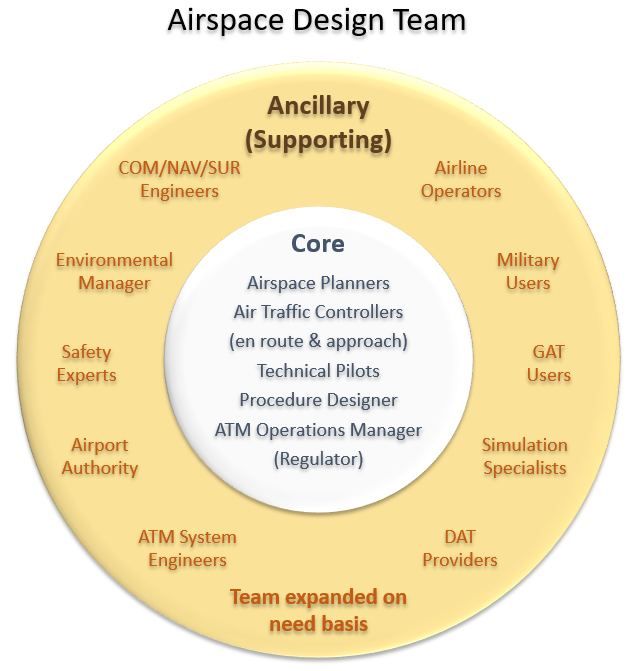To meet the operational requirements that are laid out, an Airspace Concept (a plan of the future operations) will need to be developed, validated and implemented. Such an Airspace Concept, which addresses all of the requirements, cannot be developed by a single individual working in isolation; the building of this Airspace Concept requires the involvement of all stakeholders:
- the people who fly in the airspace (the pilots)
- the people who manage the airspace (the controllers)
- the people who place the flows of traffic (the designers)
- the people who provide the technical support (the CNS technicians)
- the people who understand flow and capacity (the ATM specialists)
- the people who will sign off on the operations (the regulators).
Many unsuccessful airspace changes occur because either the airspace users or the controllers do not ‘buy in’ to the new design. By involving the people that the change will affect will hopefully create a level of ownership in that airspace change.

Therefore, Airspace Concepts, from inception to implementation, are the product of an integrated team of people working together: the example shown is a typical but not exclusive, Airspace Design Team.
Commonly, this team is led by an ATM specialist with an in-depth operational knowledge of the specific airspace under review and a sound knowledge of PBN. This specialist needs to be supported by the Air Traffic Controllers familiar with the airspace in question, ATM and CNS System specialists and Technical pilots from lead carriers operating in the specific airspace. The Instrument Flight Procedure designers play an integral role in this team as do the data houses, airspace users, regulatory authorities, safety and environmental managers. However, whilst certain members in the team will work continuously on the project and will form the nucleus, or core, of the team, other team members will only be needed when their expertise is needed.
PBN is no longer a new concept. However, it is perfectly possible that some of the team will not be as familiar with PBN as others. Therefore, a solid check of PBN understanding within the team is highly recommended prior to undertaking the development of the airspace plan. Where there are clear knowledge differences then PBN training should be undertaken to ensure common understanding of the concept.
Once a mutual level of PBN knowledge is assured within the team then the team leader can assign the roles and responsibilities to the team members and each member needs to clearly understand the speed, timing and content of individual contributions which will be needed.
Finally, it is always beneficial for the team to understand how their project will sit in the bigger picture. This will help with connectivity and, hopefully, the design of the most efficient flows. In addition, it is also beneficial to understand the level of empowerment that this design team has. Is the team empowered to make system changes, which may have significant cost implications, or is that for a higher level of management to decide?